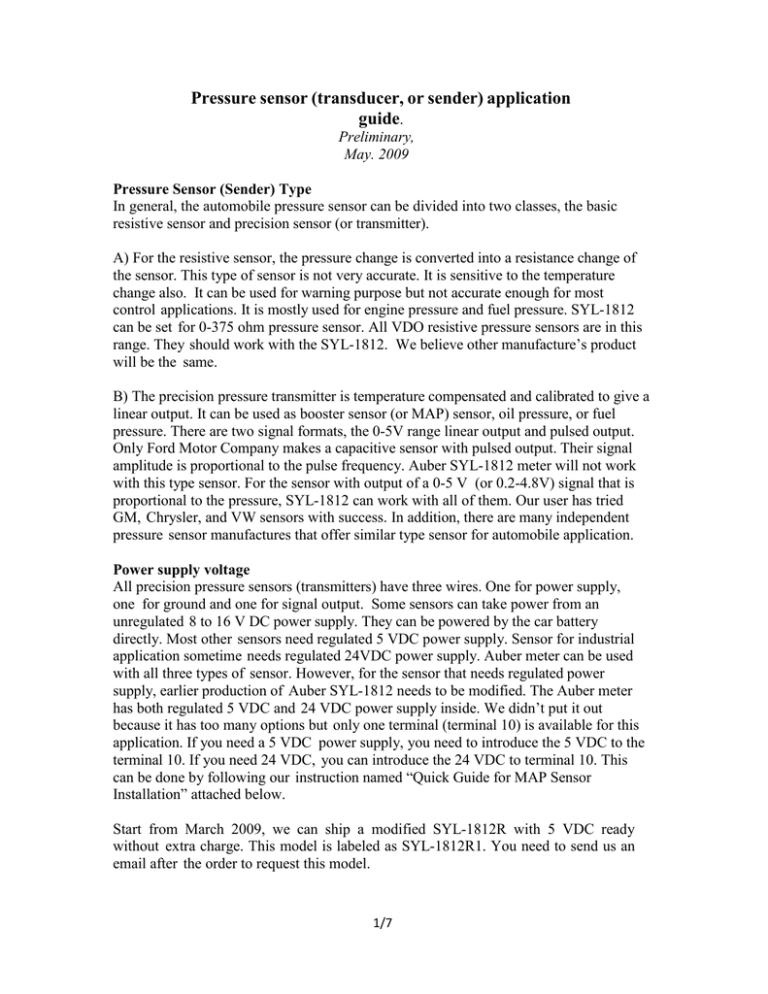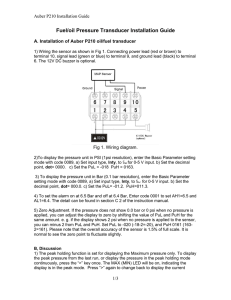
Pressure sensor (transducer, or sender) application
guide.
Preliminary,
May. 2009
Pressure Sensor (Sender) Type
In general, the automobile pressure sensor can be divided into two classes, the basic
resistive sensor and precision sensor (or transmitter).
A) For the resistive sensor, the pressure change is converted into a resistance change of
the sensor. This type of sensor is not very accurate. It is sensitive to the temperature
change also. It can be used for warning purpose but not accurate enough for most
control applications. It is mostly used for engine pressure and fuel pressure. SYL-1812
can be set for 0-375 ohm pressure sensor. All VDO resistive pressure sensors are in this
range. They should work with the SYL-1812. We believe other manufacture’s product
will be the same.
B) The precision pressure transmitter is temperature compensated and calibrated to give a
linear output. It can be used as booster sensor (or MAP) sensor, oil pressure, or fuel
pressure. There are two signal formats, the 0-5V range linear output and pulsed output.
Only Ford Motor Company makes a capacitive sensor with pulsed output. Their signal
amplitude is proportional to the pulse frequency. Auber SYL-1812 meter will not work
with this type sensor. For the sensor with output of a 0-5 V (or 0.2-4.8V) signal that is
proportional to the pressure, SYL-1812 can work with all of them. Our user has tried
GM, Chrysler, and VW sensors with success. In addition, there are many independent
pressure sensor manufactures that offer similar type sensor for automobile application.
Power supply voltage
All precision pressure sensors (transmitters) have three wires. One for power supply,
one for ground and one for signal output. Some sensors can take power from an
unregulated 8 to 16 V DC power supply. They can be powered by the car battery
directly. Most other sensors need regulated 5 VDC power supply. Sensor for industrial
application sometime needs regulated 24VDC power supply. Auber meter can be used
with all three types of sensor. However, for the sensor that needs regulated power
supply, earlier production of Auber SYL-1812 needs to be modified. The Auber meter
has both regulated 5 VDC and 24 VDC power supply inside. We didn’t put it out
because it has too many options but only one terminal (terminal 10) is available for this
application. If you need a 5 VDC power supply, you need to introduce the 5 VDC to the
terminal 10. If you need 24 VDC, you can introduce the 24 VDC to terminal 10. This
can be done by following our instruction named “Quick Guide for MAP Sensor
Installation” attached below.
Start from March 2009, we can ship a modified SYL-1812R with 5 VDC ready
without extra charge. This model is labeled as SYL-1812R1. You need to send us an
email after the order to request this model.
1/7
Appendix 1, Set up for GM 12223861 3 Bar MAP Sensor or Auber 103
MAP Sensor
In order to display the pressure in correctly, we need to find what the meter should
display when voltage input is 0V and 5V, assuming the input signal is linear in the entire
0-5V range.
GM published data.
For display in Bar,
0.4 bar = 0.619V
3.04 bar =4.818 V
Because the signal is linear in that range, it can be represent by
V=axP+b
Where P is the pressure, V is the voltage. a, is the slop, b is the intersection at zero
pressure,
To find slop a.
a= (4818-0.0.619)/(3.04-0.4) = 1.5905
To find intersection b
b = V- a x P= 4.818- 3.04x1.5905 =-0.01712
So, V = 1.5905P – 0.01712, or P = (V + 0.01712)/1.5905
Assume the sensor is liner over the 0-5V range
Then,
At 0 V, P = 0.01076,
At 5 V, P = 3.154.
To display in absolute pressure,
Set dot to 00.00,
PuL=0.01,
PuH=3.15
If you want display to show zero at atmosphere pressure (standard atmosphere=1.00bar),
(let 1 bar display as zero pressure),
PuL = 0.01076-1 = -0.99,
PuH = 3.154-1 = 2.15
For display in PSI, 1bar=14.503PSI
To display in absolute pressure,
Set dot to 000.0,
PuL=0.2,
PuH=45.7
2/7
If you want display to show zero at atmosphere pressure (standard atmosphere=1.00bar),
then
PuL= - 14.4, PuH = 31.2
Please note, the meter will not display zero pressure unless the absolute barometer
pressure is 1.00 bars. The barometer reported from location weather station is the
pressure converted at sea level, or relative barometer. It is not the absolute barometer
pressure at the local altitude.
B) Connecting the pressure transducer. The ground should be connected to terminal 6.
Signal to terminal 9 and power supply to terminal 10.
3/7
Appendix 2
Earlier SYL-1812 model modification guide for MAP Sensor
Installation.
A). Introducing the regulated 5 VDC to terminal 10.
1) Open the controller. Using two small flat screw drivers to press down the two taps
on the side of meter and push the back of the controller forward Fig 1 and 2.
Fig 1. Gently insert a small screw drive. Don’t press too hard. Otherwise the tap will
break.
4/7
Fig 2. With one screw drive on each side of the meter, press the back of the meter
down with two thumbs. Stop press when you feel the core of the meter has moved a
little.
2) After the meter moved slightly, remove the screw drivers and push the core of the
meter out (fig 5).
3) Solder a wire between terminal 10 and 5 VDC as marked.
Fig 3. The location of 5 VDC and terminal 10.
5/7
Fig 4. A red wire is soldered between 5VDC and terminal 10 (green arrow).
4) Put the core of the meter back to the meter shell.
Fig 5. Put the core of the meter back. Make sure the top of front is aligned with the side
of case that has AUBER name as indicated by the green arrows.
6/7
B) Connecting the pressure transducer. The ground should be connected to terminal 6.
Signal to terminal 9 and power supply to terminal 10.
Auber Instruments Inc.
5755 North Point Parkway, Suite 99,
Alpharetta, GA 30022
www.auberins.com
Email: info@auberins.com
Tel: 770-569-8420
Copyright 2007-2015, Auber Instruments All Rights Reserved.
No part of this manual shall be copied, reproduced, or transmitted in any way without the prior,
written consent of Auber Instruments. Auber Instruments retains the exclusive rights to all
information included in this document.
7/7


